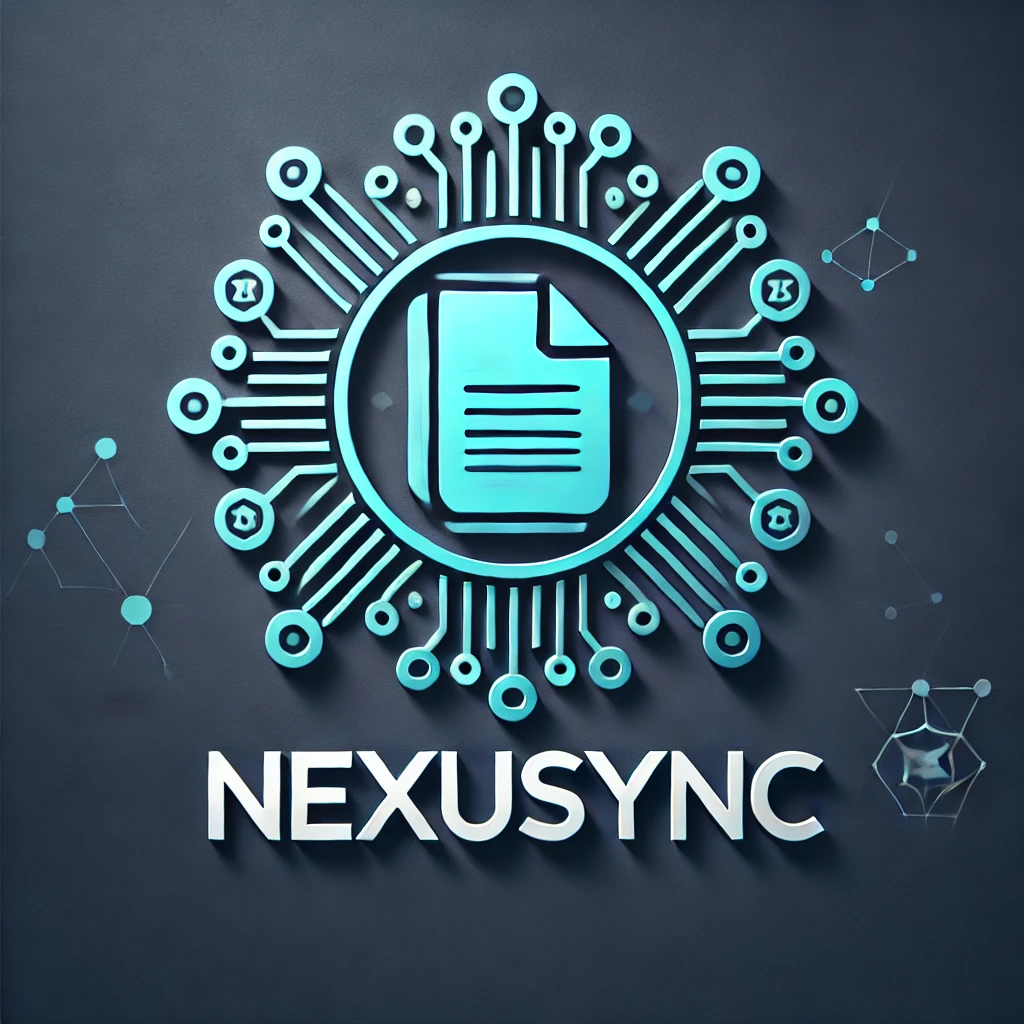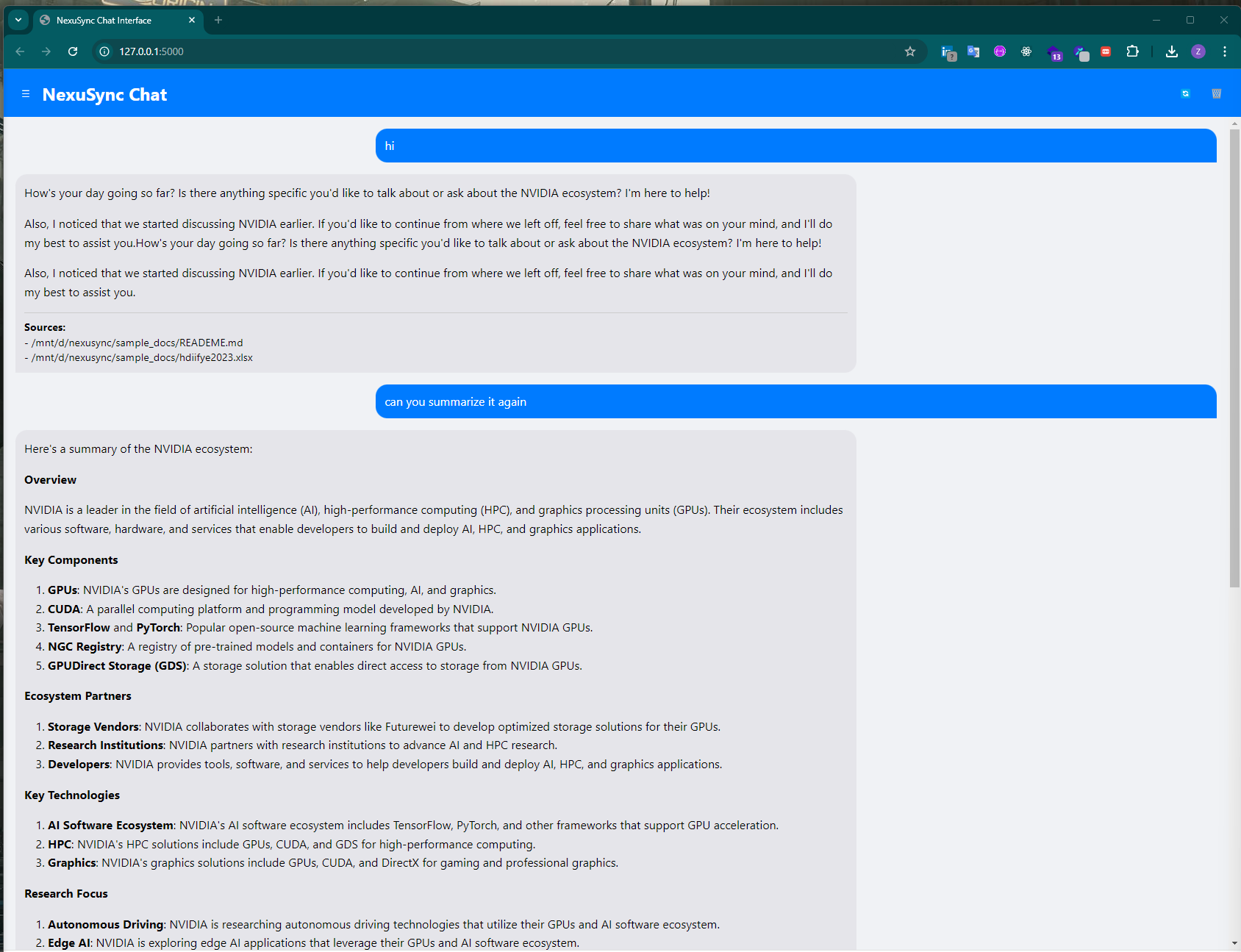Newest version = 0.3.6: torch package needs to be installed seperately to make sure your system env matches;
Development Plan for the next version:
- Adding PDF OCF using ollama llama3.2 vision
NexuSync is a lightweight yet powerful library for building Retrieval-Augmented Generation (RAG) systems, built on top of LlamaIndex. It offers a simple and user-friendly interface for developers to configure and deploy RAG systems efficiently. Choose between using the Ollama LLM model for offline, privacy-focused applications or the OpenAI API for a hosted solution.
- Lightweight Design: Simplify the integration and configuration of RAG systems without unnecessary complexity.
- User-Friendly Interface: Intuitive APIs and clear documentation make setup a breeze.
- Flexible Document Indexing: Automatically index documents from specified directories, keeping your knowledge base up-to-date.
- Efficient Querying: Use natural language to query your document collection and get relevant answers quickly.
- Conversational Interface: Engage in chat-like interactions for more intuitive information retrieval.
- Customizable Embedding Options: Choose between HuggingFace Embedding models or OpenAI's offerings.
- Incremental Updates: Easily update and insert new documents into the index or delete the index for removed documents.
- Automatic Deletion Handling: Documents removed from the filesystem are automatically removed from the index.
- Extensive File Format Support: Supports multiple file formats including
.csv,.docx,.epub,.hwp,.ipynb,.mbox,.md,.pdf,.png,.ppt,.pptm,.pptx,.json, and more.
- Python 3.10 or higher
- Install Pytorch, please visit https://pytorch.org/get-started/locally/
- Install Ollama: https://ollama.com/download or OpenAI API (need to create .env file to include OPENAI_API_KEY = 'sk-xxx')
- Suggested to use conda for your env control to avoid enviroment conflicts:
Install conda for WSL2 (Windows Subsystem for Linux 2):
- Open your WSL2 terminal
- Download the Miniconda installer:
wget https://repo.anaconda.com/miniconda/Miniconda3-latest-Linux-x86_64.sh - Run the installer:
bash Miniconda3-latest-Linux-x86_64.sh - Follow the prompts to complete the installation
- Restart your terminal or run source ~/.bashrc
Install conda for Windows:
- Download the Miniconda installer for Windows from https://docs.conda.io/en/latest/miniconda.html
- Run the .exe file and follow the installation prompts
- Choose whether to add Conda to your PATH environment variable during installation
Install conda for Linux:
- Open a terminal
- Download the Miniconda installer
wget https://repo.anaconda.com/miniconda/Miniconda3-latest-Linux-x86_64.sh - Run the installer:
bash Miniconda3-latest-Linux-x86_64.sh4.Follow the prompts to complete the installation - Restart your terminal or run
source ~/.bashrc
Install conda for macOS:
- Open a terminal
- Download the Miniconda installer
curl -O https://repo.anaconda.com/miniconda/Miniconda3-latest-MacOSX-x86_64.sh - Run the installer:
bash Miniconda3-latest-MacOSX-x86_64.sh4.Follow the prompts to complete the installation - Restart your terminal or run
source ~/.bash_profile
After installation on any platform, verify the installation by running:
conda --version
- Use conda to create env in your project folder:
conda create env --name <your_env_name> python=3.10
conda activate <your_env_name>- Then, install NexuSync under your conda env, run the following command:
pip install nexusyncOr git clone https://github.com/Zakk-Yang/nexusync.git
- Install pytorch (https://pytorch.org/get-started/locally/):
- If you are using cuda, make sure your cuda version matches:
- For CUDA 11.8 (example, for windows and wsl2/linux)
pip3 install torch torchvision torchaudio --index-url https://download.pytorch.org/whl/cu118 - For CUDA 12.1 (example, for windows and wsl2/linux)
pip3 install torch torchvision torchaudio --index-url https://download.pytorch.org/whl/cu121 - For macOS
pip3 install torch torchvision torchaudio
- For CUDA 11.8 (example, for windows and wsl2/linux)
Here's how you can get started with NexuSync:
from nexusync import NexuSync#------- Use OpenAI Model -------
# Customize your parameters for openai model, create .env file in the project folder to include OPENAI_API_KEY = 'sk-xxx'
OPENAI_MODEL_YN = True
EMBEDDING_MODEL = "text-embedding-3-large"
LANGUAGE_MODEL = "gpt-4o-mini"
TEMPERATURE = 0.4 # range from 0 to 1, higher means higher creativitiy level
CHROMA_DB_DIR = 'chroma_db' # Your path to the chroma db
INDEX_PERSIST_DIR = 'index_storage' # Your path to the index storage
CHROMA_COLLECTION_NAME = 'my_collection'
INPUT_DIRS = ["../sample_docs"] # can specify multiple document paths
CHUNK_SIZE = 1024 # Size of text chunks for creating embeddings
CHUNK_OVERLAP = 20 # Overlap between text chunks to maintain context
RECURSIVE = True # Recursive or not under one folder#------- Use Ollama Model -------
# Customize your parameters for ollama model
OPENAI_MODEL_YN = False # if False, you will use ollama model
EMBEDDING_MODEL = "BAAI/bge-base-en-v1.5" # suggested embedding model, you can replace with any HuggingFace embedding models
LANGUAGE_MODEL = 'llama3.2' # you need to download ollama model first, please check https://ollama.com/download
BASE_URL = "http://localhost:11434" # you can swith to different base_url for Ollama model
TEMPERATURE = 0.4 # range from 0 to 1, higher means higher creativitiy level
CHROMA_DB_DIR = 'chroma_db' # Your path to the chroma db
INDEX_PERSIST_DIR = 'index_storage' # Your path to the index storage
CHROMA_COLLECTION_NAME = 'my_collection'
INPUT_DIRS = ["../sample_docs"] # can specify multiple document paths
CHUNK_SIZE = 1024 # Size of text chunks for creating embeddings
CHUNK_OVERLAP = 20 # Overlap between text chunks to maintain context
RECURSIVE = True # Recursive or not under one folder# example for Ollama Model
ns = NexuSync(input_dirs=INPUT_DIRS,
openai_model_yn=False,
embedding_model=EMBEDDING_MODEL,
language_model=LANGUAGE_MODEL,
base_url = BASE_URL, # OpenAI model does not need base_url, here we use Ollama Model as an example
temperature=TEMPERATURE,
chroma_db_dir = CHROMA_DB_DIR,
index_persist_dir = INDEX_PERSIST_DIR,
chroma_collection_name=CHROMA_COLLECTION_NAME,
chunk_overlap=CHUNK_OVERLAP,
chunk_size=CHUNK_SIZE,
recursive=RECURSIVE
)#------- Start Quering (one-time, no memory and without stream chat) -----
query = "main result of the paper can llm generate novltive ideas"
text_qa_template = """
Context Information:
--------------------
{context_str}
--------------------
Query: {query_str}
Instructions:
1. Carefully read the context information and the query.
2. Think through the problem step by step.
3. Provide a concise and accurate answer based on the given context.
4. If the answer cannot be determined from the context, state "Based on the given information, I cannot provide a definitive answer."
5. If you need to make any assumptions, clearly state them.
6. If relevant, provide a brief explanation of your reasoning.
Answer: """
response = ns.start_query(text_qa_template = text_qa_template, query = query )
print(f"Query: {query}")
print(f"Response: {response['response']}")
print(f"Response: {response['metadata']}")# First, initalize the stream chat engine
ns.initialize_stream_chat(
text_qa_template=text_qa_template,
chat_mode="context",
similarity_top_k=3
)
query = "main result of the paper can llm generate novltive ideas"
for item in ns.start_chat_stream(query):
if isinstance(item, str):
# This is a token, print or process as needed
print(item, end='', flush=True)
else:
# This is the final response with metadata
print("\n\nFull response:", item['response'])
print("Metadata:", item['metadata'])
breakchat_history = ns.chat_engine.get_chat_history()
print("Chat History:")
for entry in chat_history:
print(f"Human: {entry['query']}")
print(f"AI: {entry['response']}\n")#------- Incrementaly Refresh Index without Rebuilding it -----
# If you have files modified, inserted or deleted, you don't need to rebuild all the index
ns.refresh_index()#------- Rebuild Index -----
# Rebuild the index when either of the following is changed:
# - openai_model_yn
# - embedding_model
# - language_model
# - base_url
# - chroma_db_dir
# - index_persist_dir
# - chroma_collection_name
# - chunk_overlap
# - chunk_size
# - recursive
from nexusync import rebuild_index
from nexusync import NexuSync
OPENAI_MODEL_YN = True # if False, you will use ollama model
EMBEDDING_MODEL = "text-embedding-3-large" # suggested embedding model
LANGUAGE_MODEL = 'gpt-4o-mini' # you need to download ollama model first, please check https://ollama.com/download
TEMPERATURE = 0.4 # range from 0 to 1, higher means higher creativitiy level
CHROMA_DB_DIR = 'chroma_db'
INDEX_PERSIST_DIR = 'index_storage'
CHROMA_COLLECTION_NAME = 'my_collection'
INPUT_DIRS = ["../sample_docs"] # can specify multiple document paths
CHUNK_SIZE = 1024
CHUNK_OVERLAP = 20
RECURSIVE = True
# Assume we changed the model from Ollama to OPENAI
rebuild_index(input_dirs=INPUT_DIRS,
openai_model_yn=OPENAI_MODEL_YN,
embedding_model=EMBEDDING_MODEL,
language_model=LANGUAGE_MODEL,
temperature=TEMPERATURE,
chroma_db_dir = CHROMA_DB_DIR,
index_persist_dir = INDEX_PERSIST_DIR,
chroma_collection_name=CHROMA_COLLECTION_NAME,
chunk_overlap=CHUNK_OVERLAP,
chunk_size=CHUNK_SIZE,
recursive=RECURSIVE
)
# Reinitiate the ns after rebuilding the index
ns = NexuSync(input_dirs=INPUT_DIRS,
openai_model_yn=OPENAI_MODEL_YN,
embedding_model=EMBEDDING_MODEL,
language_model=LANGUAGE_MODEL,
temperature=TEMPERATURE,
chroma_db_dir = CHROMA_DB_DIR,
index_persist_dir = INDEX_PERSIST_DIR,
chroma_collection_name=CHROMA_COLLECTION_NAME,
chunk_overlap=CHUNK_OVERLAP,
chunk_size=CHUNK_SIZE,
recursive=RECURSIVE
)
# Test the new built index
query = "main result of the paper can llm generate novltive ideas"
text_qa_template = """
Context Information:
--------------------
{context_str}
--------------------
Query: {query_str}
Instructions:
1. Carefully read the context information and the query.
2. Think through the problem step by step.
3. Provide a concise and accurate answer based on the given context.
4. If the answer cannot be determined from the context, state "Based on the given information, I cannot provide a definitive answer."
5. If you need to make any assumptions, clearly state them.
6. If relevant, provide a brief explanation of your reasoning.
Answer: """
response = ns.start_query(text_qa_template = text_qa_template, query = query )
print(f"Query: {query}")
print(f"Response: {response['response']}")
print(f"Response: {response['metadata']}")- git clone or download this project:
git clone https://github.com/Zakk-Yang/nexusync.git- Configure Backend
- Open back_end_api.py in your IDE.
- Adjust the parameters according to your requirements.
- Open the terminal and run
python back_end_api.py
Ensure that the parameters in back_end_api.py align with the settings in the side panel of the interface. If not, copy and paste your desired Embedding Model and Language Model in the side panel and click "Apply Settings".
- Start interacting with your data!
For more detailed usage examples, check out the demo notebooks.
This project is licensed under the MIT License - see the LICENSE file for details.
For questions or suggestions, feel free to open an issue or contact the maintainer:
Name: Zakk Yang Email: zakkyang@hotmail.com GitHub: Zakk-Yang
If you find this project helpful, please give it a ⭐ on GitHub! Your support is appreciated.


